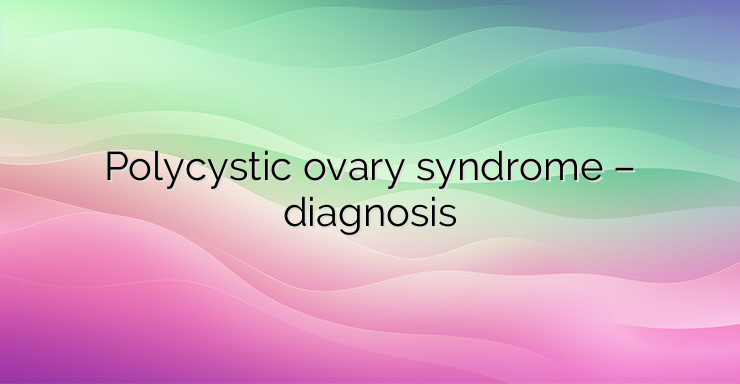Polycystic ovary syndrome (PCOS) is a diagnosis that can be made after excluding other conditions associated with irregular periods, infertility and manifestations of increased male sex hormones (acne, hair loss, increased hair growth). For this purpose, it is important to take a detailed history and physical examination, as well as conduct some hormonal and imaging tests. Conditions to rule out before making a diagnosis of PCOS are: Androgen-secreting tumors of the adrenal glands and ovaries; Taking testosterone preparations (e.g. anabolic steroids); Cushing’s syndrome; Late form of adrenal cortical hyperplasia; Acromegaly; Genetic defects of the insulin receptor; Primary hypothalamic amenorrhea; Primary ovarian failure; Diseases of the thyroid gland; Hyperprolactinemia. The beginning and type of menstrual disorders are sought in the anamnesis. Did they occur soon after menarche (first period) or was there a period of normal cycle after which a problem occurred. The same applies to the signs of hyperandrogenism – acne, hirsutism (increased hair growth) and hair loss (alopecia). Body weight history is taken: is there weight gain, when did it start and at what rate of gain. Family burden is also important. Often, women with PCOS have female relatives with signs of the disease. Also, PCOS is associated with metabolic disorders, such as diabetes mellitus, and cardiovascular disease in personal and family history. PCOS can also be suspected in women who have had gestational diabetes. Physical examination pays attention to signs of hyperandrogenism. The skin is examined, which may have oiliness and acne. The severity and prevalence of acne is assessed. They look around the so-called androgen-dependent areas of increased hair growth. These include the face, shoulders, chest, back, abdomen and inner thighs. Hairiness is assessed using the Ferriman-Gallawey scale. The presence of more than 8 points means that hirsutism is present. Scalp hair is assessed and signs of male pattern baldness are looked for. It is characterized by hair loss in the crown area. In contrast, female pattern baldness starts from the area around the temples. Body distribution is assessed. Weight, height and waist and hip circumferences are measured. On this basis, it can be assessed whether there is obesity and fat deposition in the area around the abdomen. Abdominal obesity is associated with a greater risk of metabolic and cardiovascular disease. It is also associated with insulin resistance, as its manifestation can be the so-called acanthosis nigricans. This is a characteristic darkening of the skin in the area of the neck, elbows and skin folds under the arms, chest, etc. The patient is necessarily referred for an ultrasound scan of the small pelvis to assess the size of the ovaries, the presence of cysts or a dominant follicle, respectively, and suspected ovulation.Two of the diagnostic criteria for PCOS are the absence of ovulation and the presence of polycystic ovaries. Ultrasound ovaries with a volume of more than 10 ml or with the presence of at least 20 visible follicles (cysts). Examination of the external genitalia may also show signs of hyperandrogenism, such as enlargement of the clitoris (clitoromegaly) and fusion of the labia in the form of a “false” scrotum. These signs are more characteristic of congenital adrenal hyperplasia. It is a genetic disease with a defect in the formation of cortisol with a deviation of steroidogenesis towards increased synthesis of androgens. The laboratory analysis includes: Examination of androgens – testosterone, dehydroepiandrosterone-sulfate (DHEA-C), androstenedione. Testosterone is formed mainly by the ovaries, and the remaining two by the adrenal gland; Function of the thyroid gland with the study of thyroid-stimulating hormone – TSH. Prolactin test; 17-OH-progesterone is a cortisol precursor that accumulates in large amounts in adrenocortical hyperplasia (ACH). Research in the direction of Cushing’s syndrome or acromegaly, with concomitant signs of these diseases. Conducting an oral glucose tolerance test (OGTT) with blood sugar and insulin testing during the test – to assess carbohydrate disorders and insulin resistance. Lipid profile. In addition, gonadotropic hormones (LH, FSH) and estradiol can be tested to clarify the cause of missing menstruation. References: Legro RS. Evaluation and Treatment of Polycystic Ovary Syndrome. 2017 Jan 11. Endotext [Internet]. South Dartmouth (MA): MDText.com, Inc.; 2000–. PMID: 25905194.to clarify the reason for missing menstruation. References: Legro RS. Evaluation and Treatment of Polycystic Ovary Syndrome. 2017 Jan 11. Endotext [Internet]. South Dartmouth (MA): MDText.com, Inc.; 2000–. PMID: 25905194.to clarify the reason for missing menstruation. References: Legro RS. Evaluation and Treatment of Polycystic Ovary Syndrome. 2017 Jan 11. Endotext [Internet]. South Dartmouth (MA): MDText.com, Inc.; 2000–. PMID: 25905194.


Leave a Reply